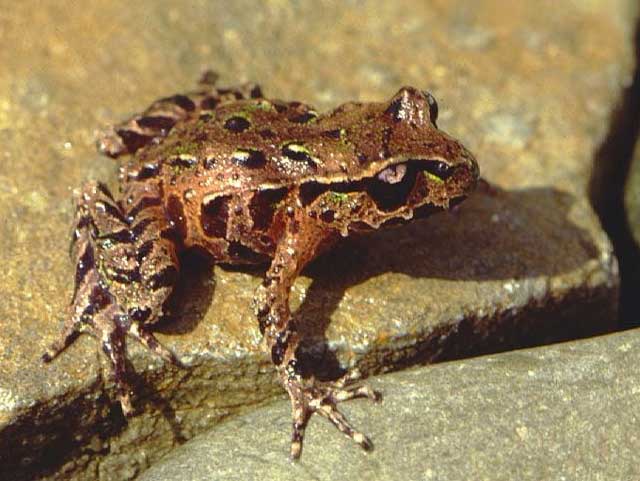Leiopelma archeyi (*) Cladus: Eukaryota Name Leiopelma archeyi Turbott, 1942 Type locality: "Tokatea, near Coromandel", Cape Colville Range, New Zealand. Holotype: AIM. References * Bell, B.D.; Daugherty, C.H.; Hitchmough, R.A. 1998: The taxonomic identity of a population of terrestrial Leiopelma (Anura: Leiopelmatidae) recently discovered in the northern King Country, New Zealand. New Zealand journal of zoology, 25: 139-146. [1]
Archey's frog, Leiopelma archeyi, is a New Zealand primitive frog, one of only four belonging to the ancient family Leiopelmatidae. It is named after Sir Gilbert Archey (1890–1974), the former Director of the Auckland Institute.[2] It is found only in the Coromandel Peninsula and near Te Kuiti in the North Island of New Zealand. The species is fully terrestrial, living and reproducing under damp vegetation in native forests. Currently its distribution is confined to higher elevations although just 15 years ago the species was abundant even near sea level. Little is known about the natural history of this species. Although the species is sexually monomorphic, males are believed to be the primary care providers, and may prepare "nests" that they guard for the eggs, and secrete antimicrobial peptides onto them, to ensure successful embryonic development. Clutch sizes vary between 4 and 10 eggs. Reproduction is fully terrestrial; tadpoles develop within gelatinous egg capsules, and upon hatching, tailed froglets crawl onto the male's back and are carried around for several weeks. Adult frogs do not give advertisement vocalisations, but may communicate by chemical signalling. However, frogs sometimes give startle calls when threatened by a predator. An intensively monitored population in one Cormandel site declined by 88% from 1996 to 2001 [3] but in many areas where frogs previously were common, none remain. Because populations are rapidly declining, and reproduction is infrequent, the species is at significant risk of imminent extinction. As first shown by Bruce Waldman,[4] the species appears to have an intrinsic low level of susceptibility to chytridiomycosis.[5] However, frogs in the field show clinical signs, including blisters, that may be associated with other diseases. A captive breeding programme was established at the University of Canterbury in 2002 to safeguard the species from disease,[6] and frogs successfully bred. The programme was transferred to Auckland Zoo in 2005, where over half of the frogs, including juveniles bred at the Canterbury facility, died; none have since reproduced.[7] It is classed as Nationally Critical in the New Zealand Threat Classification System.[8] References 1. ^ Bell (2004). Leiopelma archeyi. 2006. IUCN Red List of Threatened Species. IUCN 2006. www.iucnredlist.org. Retrieved on 11 May 2006. Database entry includes a range map, a brief justification of why this species is critically endangered, and the criteria used Source: Wikipedia, Wikispecies: All text is available under the terms of the GNU Free Documentation License |
|

